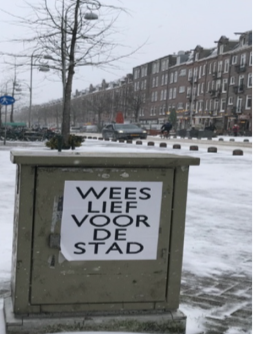Blog
Creative Urban Methods: Photo-walk your neighborhood
Irina van Aalst
Long time photographs in Urban Geography has been used as illustration of a specific situation or objective representations of research. In recent years, interest for using photographs as a method has still increased. Visual culture has become more central in people’ s everyday lives, everyone has a camera in their pocket, and social media are greatly affecting our ways of engaging with pictures. Visual methods can be used to provide in-depth understandings of daily urban places in which people meet, recreate, work and live.
Photography is a creative method and tool for making theoretical concepts visible in streetscapes, to grasp the experiences or atmospheres of a specific urban place and to think and understand the urban environment from various perspectives. Photography and photo-walking can be introduced as part of mobile methods, like interviewing in go-alongs.



Pictures taken by Master students Human Geography, class 20-21
Photo-walk your neighborhood
In our course Visual methods (Utrecht University) we trained Master’s students Human Geography in the use of mental mapping, photo voicing and (auto-)photography for doing qualitative research. Students were encouraged to explore their everyday environments by dwelling, walking and doing (auto-)photography. Main aim was to reflect on everyday practices, to deepen understandings of the world around them and to get a relational understanding of human and non-human entities in space. These photo walks were creative encounters with daily spaces and were inspired by the urban flaneurs of Baudelaire and the Situationists (1950s) who explored the city by drifting freely through it.
This year (2021) students take pictures of visible signs and changes, in social behavior and the use of public spaces, due to Covid19 regulations. While looking through a lens they critically reflect on how Covid19 affect the material city, other people and their own feelings. They all choose a part of their daily and familiar neighborhood by looking “at the world anew”. As Pyyry (2016, 102) stated: “(…) through the lens of the camera, you don’t take these places for granted anymore, but became aware of local relations and processes. Photography is used as a method to ‘make the familiar unfamiliar’ and question the ‘taken-for-granted’ ”.



Pictures taken by Master students Human Geography, class 20-21
Surprising paradoxes: emptiness – unsafety – streetlive
A number of students show us the consequences of the closed stores and the revival of the delivery economy: empty boxes on the street in front of the facades of the closed facilities. Not only a lot of clutter and reduction of livability but also less people in the streets and squares. Now they see that the many urban facilities are not only physical buildings but they also provide social surveillance opportunities through “eyes on the street”. Especially female students explicitly noted that this assignment made them thinking about safety in public spaces.
At the same time, the “to-go” economy creates much more interaction and contact on the street especially during the day. Covid19 puts pressure on urban public space. Where people live smaller and many are forced to work from home, there is a need for outdoor air and a stroll, after the countless video calls with colleagues. Because of the virus urban public spaces become a high-risk place dominated by arrows, red and white ribbons, rules, warning signs and traffic circles. The outdoor space increasingly resembles an indoor space with all those rules. Windows become communication columns with messages of hope, emotions and solidarity.
Pictures taken by Master students Human Geography, class 20-21
Taking pictures really stimulate thinking by concentrating on what happens in situ. It could also stimulate dialogues about important issues through group discussions. Furthermore it will be more easy to discuss local issues with policymakers and community leaders and give voice and empower people like children and youth.
References
Benzon, N. von, Holton, M., Wilinson, C. and S. Wilkinson (eds) (2021), Creative methods for human geographers. London: Sage.
Hall, T. (2009) The camera never lies? Photographic research methods in Human Geography. Journal of Geography in Higher Education 33(3), 453-462.
Hees, S. van, K. Horstman, M. Jansen, D. Ruwaard (2017) Photovoicing the neighbourhood: Understanding the situated meaning of intangible places for ageing-in-place. Health & Place 48, 11-19.
Kusenbach, M. (2012) ‘Mobile methods’, in S. Delamont (ed.), Handbook of Qualitative Research in Education. Cheltenham: Edward Elgar Publishing, 252 – 64.
Pyyry, N. (2016) Learning with the city via enchantment: photo-walks as creative encounters. Discourse: Studies in the Cultural Politics of Education 37(1), 102-115.
Rose, G. (2014) ‘On the relation between “ visual research methods ” and contemporary visual culture’, The Sociological Review 62(1), 24 – 46.




